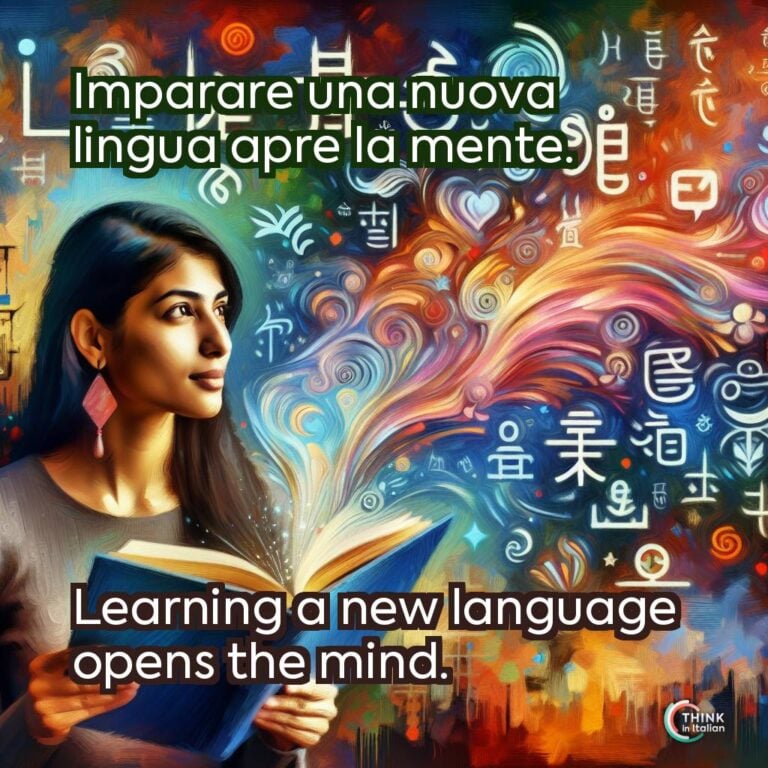The Many Faces of Me
Language and my Behavior
I’ve noticed how much my thoughts and behavior change depending on the language I’m speaking. It’s almost like I have multiple personalities. Each language brings out a different side of me, influencing how I interact with others.
Speak Italian, and I’m suddenly more expressive and passionate. Switch to German, and I become methodical and precise. Start speaking Vietnamese, and I’m cautious and respectful. It’s like a linguistic rollercoaster, with each language pulling me in a different direction.
There’s a scientific explanation for this, but first, let me share what regularly happens to me as a polyglot. Trust me, you might not envy my predicament.
Polite Me, Brutally Honest Me
As a serial language learner, my own thoughts, words, and behavior adjust significantly depending on which language I’m speaking. Take Japanese and Korean, for example. When I speak these languages, I’m very aware of the social context and my place in it.
I remember one evening in Tokyo, sitting in a smoky izakaya with friends. I wanted to choose a smoke-free eatery, but I held back, worried about upsetting the group harmony. Speaking Japanese made me more cautious and considerate.
Indeed, when speaking Japanese or Korean, I find myself acutely aware of the social context and my relative position to others. This heightened sensitivity often leads me to refrain from expressing uncomfortable ideas like criticisms, fearing that I might disrupt group harmony.
This is in stark contrast to when I use English, where my tone becomes direct, sometimes harsh, and impatient. During a stressful business meeting with one of my assistants, I remember saying “Your work was a complete mess”. My tone was sharp and impatient, which hurt my Filipino assistant.
Amusingly enough, English is also the language my assistant switched later on to ask for a raise. Indeed, English seems to makes people more straightforward and assertive.

The Future is Now?
Bringing it closer to my experiences, in Italian, we often use the present tense to talk about the future, which could suggest a more immediate, integrated view of time.
Domani lavoro literally translates to “Tomorrow I work” using the present tense rather than the future, which might hint at how seamlessly future events are woven into our current reality.
In other languages, like Japanese, I wouldn’t use the future tense simply because there is no distinct future tense in Japanese. The same verb forms are used to express both present and future actions, relying on context to convey the time frame.
For example, “明日行きます” (ashita ikimasu) means “I go tomorrow” or “I will go tomorrow,” depending on the context. Curiously enough, relying on time expressions like “tomorrow” practically forces me to set the time even though I might not be sure about that.
Who Broke the Vase?
Growing up speaking Italian, I often used phrases like hanno rotto… (they broke…) or hanno cancellato… (they canceled…), which made it easy to avoid personal responsibility and subtly shift the blame to an unspecified group. This felt natural and was just a part of how we spoke.
When I started learning English, I noticed the emphasis on individual agency. Saying “I broke the vase” or “We decided to cancel the project” felt more direct and personal, highlighting accountability in a way I wasn’t used to. It was a shift that made me more aware of my own role in actions and decisions.
Then, diving into Japanese, I was struck by how the language often omits the subject altogether, focusing instead on the event. Phrases like “花瓶が壊れた” (the vase broke) and “プロジェクトがキャンセルされた” (the project has been canceled) minimize conflict and reflect a collective cultural mindset.
The Gender of Things
I often found myself influenced by the gender of nouns in Italian. One clear example is the feminine noun la luna (the moon). For me, la luna is a gentle, mysterious presence in the night sky, evoking a sense of beauty and calm.
I used to imagine the moon as a nurturing figure, almost like a celestial mother watching over us. When I started learning German, I discovered that the moon, “der Mond” is masculine.
It was intriguing to hear my German language exchange partner describe the moon in ways that emphasized strength and steadfastness. They saw “der Mond” as a powerful, almost stoic presence, very different from my perception.
Another example is the feminine noun la casa (the house). Growing up, I associated la casa with warmth, comfort, and nurturing, a place where family and love reside.
When I learned Spanish, which also uses the feminine “la casa”, I found similar associations. However, when I started learning Russian, I encountered “дом” (dom), which is masculine. This made me think of a house more as a structure providing security and protection, emphasizing its solidity and endurance.
Then there’s il sole (the sun) which, in Italian, is masculine. Il sole always felt like a strong, energizing force, a powerful presence that dominates the sky. In contrast, in German, “die Sonne” is feminine, and my German friends often describes it in terms of its warmth, life-giving energy, and gentle radiance.
Not to mention that many languages, like Vietnamese or Chinese, don’t use gender for nouns. This means objects and concepts are referred to in a neutral way. Without masculine or feminine labels, people may see things more straightforwardly, focusing on their actual qualities.
You and I
As an Italian native speaker, all I need to address myself and the listener is io (I) and tu (you) or the formal Lei (formal you). For me, that’s enough to cover every 1:1 social interaction.
Tu and Lei reflect degrees of closeness and formality. For example, tu is used with friends and family, while Lei is reserved for formal situations or addressing strangers.
In contrast, Vietnamese pronouns change based on age and social status. For example, “tôi” is used formally, “mình” with close friends, and “em” if you’re younger. Addressing others as “anh” or “chị” indicates older peers, while “ông” and “bà” are used for elders.
As I’m still learning Vietnamese, navigating this complex system feels like a minefield. It’s challenging to address people with the right degree of respect and intimacy, especially because I’m not good at guessing people’s ages!

Anything Between Liking and Loving?
Growing up in Italy, I always noticed how rich our language is when it comes to expressing feelings. One phrase that stands out is ti voglio bene to say that “I love you” in Italian. It’s something we say to close friends and family, showing deep affection and care without the intense romance of ti amo.
When I tell my best friend ti voglio bene it means so much more than just liking them. It’s like saying “I care deeply about you” and it really captures the warmth and bond between us.
It’s different from piacere which just means “to like” and it’s not as strong as amare which means “to love” in a romantic way.
Learning English, I realized there’s no exact equivalent. We say “I like you” or “I love you”, but nothing in between. This sometimes makes it hard to express those deep, caring feelings for friends without sounding too romantic or too casual.
Once, I tried saying “I’m fond of you”, but it felt awkward and didn’t quite capture the same heartfelt meaning.
Immersion vs. Textbooks
Learning a language in its native country is, unsurprisingly, very different from learning through books or online. Who knew that actually being in the country would help you understand cultural nuances that books can’t teach?
For example, knowing when to use tu or Lei in Italian isn’t just about grammar, it’s about reading social cues, which you learn by observing and interacting with people. Because nothing says “authentic learning experience” like navigating social etiquette in a foreign language.
In my journey, the languages I used in their social contexts profoundly influenced me. Learning Japanese in Japan and Korean in South Korea changed how I thought and behaved.
But with Turkish, Greek, or Russian, which I studied mainly online, I didn’t notice much change in myself. Apparently, sitting at my computer just doesn’t have the same cultural impact.
For instance, if you want to learn Italian through self-study or online can be flexible and accessible, but it might lack cultural context. You can master grammar and vocabulary but might struggle with real-life conversations that require cultural understanding. Shocking, I know.
However, online learning is improving with more interactive and culturally rich experiences available through virtual environments. Maybe one day, we’ll all be fluent in 30 languages from the comfort of our living rooms.
Understanding Linguistic Relativity
Making Sense of the Chaos in my Mind
Living as a polyglot, I often feel like I’m juggling multiple identities, with each language adding a new layer to my personality. This chaotic experience aligns with linguistic relativity, the theory according to which language shapes thoughts.
However, also the opposite is true: depending on one’s personality, the experience of learning a language might change. In fact, personality influences language learning, and this should be clear to both language teachers and learners.
Let me tell you about this theory so that you don’t think I’m crazy.
What is Linguistic Relativity?
Ever since I first stumbled upon the concept of linguistic relativity, or the Sapir-Whorf Hypothesis as it’s formally known, I’ve been fascinated by the idea that the language we speak might actually shape the way we think.
This theory isn’t new—it’s been around since the early 20th century, stirring debates among linguists, anthropologists, and psychologists alike. But what does it really mean?
At its core, linguistic relativity suggests that the structure of our language can influence our thought processes. Initially, this hypothesis was presented in two versions: a strong version and a weak version.
- The strong version argues that language determines thought—it’s a bold claim suggesting that without language, we couldn’t think at all.
- The weak version, which most modern researchers lean towards, proposes that language influences thought in more subtle ways.
For example, in Italian, the way you address someone can reflect and also dictate the level of formality of your conversation: Lei for formal settings and tu for informal ones. This isn’t just about politeness—it shapes how we perceive interpersonal relationships and even authority.
Current Scientific Views
Today, the consensus in the scientific community leans towards this weak version. It’s widely accepted that while our language doesn’t cage our ability to think, it does color our perceptions and interactions subtly.
This understanding opens up fascinating avenues for exploring how different languages might mold our experiences of the world.
Take color, for instance. Research shows that the Russian language has separate words for light blue (“голубой” [goluboy]) and dark blue (“синий” [siniy]), which suggests that Russian speakers might perceive these two shades as more distinct than English speakers do.
Meanwhile, in Italian, we might not have distinct single words for these shades, but we enrich the description with adjectives, like blu chiaro (light blue) and blu scuro (dark blue), which might affect how attentively we perceive color nuances.
What I find fascinating is that, based on all languages that have been studies so far, there seem to be a hierarchy about what colors a language can have.
This study was intended to challenge the Sapir-Whorf Hypothesis, and demonstrated that the basic color terms that a culture can have can be predicted by the number of color terms that the culture already has.
For instance, all cultures that were studied have terms for black (or dark) and white (or bright). If a culture has a third term for a color, that term is always red. If a culture has a fourth color, that color is either yellow or green.
The journey through linguistic relativity has only just begun, and already, the implications for multilingual individuals, like many of us navigating multiple cultures, are immense.
Language vs. Culture: A Simple Thought Experiment
Imagine if a group of Americans, typically raised in a culture that values directness and individualism, were to grow up speaking Japanese, a language steeped in subtleties and a strong sense of in-group harmony.
Would they still uphold the same cultural values typical of American society? Or would the language structure and inherent cultural lessons lead them to adopt different aspects of Japanese behavioral norms?
Conversely, if Japanese were raised speaking only English in Japan, the directness and emphasis on individualism intrinsic to English might clash with or reshape traditional Japanese values of group harmony and subtlety.
These hypothetical scenarios highlight how language and culture jointly mold our identities and behaviors, potentially leading to unique cultural amalgamations.
The Multilingual Mind
Behavioral Shifts in Multilinguals
Navigating multiple languages daily is like switching between different cultural lenses—each language can bring out a different side of us.
I’ve noticed that when I speak Italian, I might be more expressive with my emotions and gestures, aligning with the vibrant and passionate cultural undertones of Italy. In contrast, when I switch to Japanese, my demeanor tends to be more reserved, reflecting the nature of the Japanese-speaking culture.
Studies support these personal observations, suggesting that multilingual people often exhibit shifts in personality, emotional expression, and even ethical decisions depending on the language they’re using.
For example, a decision made in Italian might lean towards emotional considerations, whereas in English, it might be more utilitarian. This phenomenon, known as “cultural frame switching“, illustrates the profound impact of language on our personal identity and interactions.
Emotional and Cognitive Flexibility
Multilingual individuals often have a more flexible approach to problem-solving. This cognitive flexibility comes from the need to switch between different syntactic structures and vocabulary, which exercises the brain in unique ways.
For example, when faced with a challenge, I might unconsciously draw from a broader range of strategies due to my experience juggling different linguistic frameworks.
Given my passion for psycholinguistics, I cannot refrain from sharing this amazing fact: multilingualism is strictly linked to the Theory of Mind (ToM), a theory that dates back to the 90s and was explored by Baron-Cohen for the first time ever, providing a new perspective in psycholinguistic studies.
ToM investigates how neurotypically developed humans ascribe mental states, beliefs, desires, and intentions to other people to understand and predict their behavior. Interestingly, research suggests that multilingual individuals may develop a more advanced ToM.
The reasons behind this claim are different:
- Perspective-Taking: multilingual people often switch between languages depending on their conversational partner’s language and cultural background. I will further discuss this topic a few lines below!
- Cultural Exposure: being fluent in multiple languages often means being exposed to multiple cultures. This exposure can lead to a deeper understanding of different mental states and social norms, fostering a more nuanced ToM.
- Cognitive Benefits: multilingualism has been associated with various cognitive benefits, including better attention and executive function. These skills are closely linked to ToM, as they involve processing and responding to multiple streams of information about people’s intentions and emotions.
Adapting Communication Styles
As mentioned before, as a multilingual person, I often adapt my communication style to align with the cultural norms associated with each language I speak. This isn’t just about choosing the right words; it’s about adjusting tone, gestures, and even the pace of speech.
This is strictly linked to the ToM, language because knowing what language other people are able to understand, allows speakers to choose the right communication means.
Based on what scientific evidence claims, this regular switching encourages me and all the other multilinguals in the world to adopt my perspectives of others more frequently, enhancing ToM.
In fact, multilinguals are shown to have a more developed ToM, because they must be able to know when, with whom, and how to switch from a language to another in conversations.
Language-Specific Memories
One of the most captivating aspects of being multilingual is how certain memories are tied to specific languages. I might recall a childhood memory more vividly when discussing it in Italian, perhaps because that was the language I spoke in that context.
This linkage between language and memory underscores the deep connections between our linguistic abilities and our autobiographical memories.
The Ups and Downs of Multilingual Life
In conclusion, I often feel like I have different personalities in different languages. However, this sensation is most pronounced because I’m both bilingual and bicultural. It’s heavily influenced by how I perceive each language and its cultural context, not just the language itself.
From a theoretical perspective, this phenomenon aligns with the concept of linguistic relativity, which suggests that language shapes thought and perception. Pronouns and expressions of affection vary across languages, reflecting cultural values and social norms.
Ultimately, learning all these languages has turned my thoughts and life into a delightful mess. But it’s a mess that has enriched my cognitive flexibility, enhanced my emotional and social awareness, and deepened my understanding of cultural contexts.
This intricate interplay between language, thought, and culture underscores the transformative—and sometimes chaotic—power of multilingualism.








